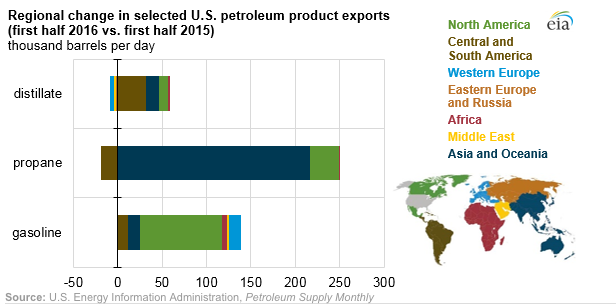A recent Today in Energy looks at the correlation between the growth of propane exports and growth in exports of petroleum products. According to U.S. Energy Information Administration data (EIA), during the first half of 2016, the U.S. exported 4.7 million barrels petroleum products per day. This is an increase of 500,000 b/d over the first half of 2015 and nearly 10 times the crude oil export volume. During the same time period, propane exports increased by more than 230,000 b/d while distillate (50,000 b/d) and gasoline (140,000 b/d) exports also increased. During the first six months of this year, propane has surpassed motor gasoline exports to become the second-largest petroleum product export.
However, while export volume increased, export destinations remained largely unchanged. Top countries included Mexico (775,000 b/d), Canada (579,000 b/d) and the Netherlands (271,000 b/d). EIA reports that the majority of petroleum exports stay in the Western Hemisphere with nearly 60 percent of total petroleum product exports in 2015 going to this region, down slightly from 65 percent in 2005.
U.S. propane exports increased from 562,000 b/d in the first half of 2015 to 793,000 b/d in the same period of 2016 with exports to Asia and Oceania accounting for 94 percent of growth. Japan imported the most U.S. propane at 159,000 b/d in the first half of 2016, an increase of 111,000 b/d from 48,000 b/d in the same period of 2015. Panama, historically a stable export market, decreased from 41,000 b/d in the first half of 2015 to 7,000 b/d in the first half of 2016.
Today in Energy reports that the large increases in propane exports to Japan and decreases in propane exports to Panama could be a result of reduced ship-to-ship transfer activity. However, the analysis found that some of the propane exports from the U.S. that undergo ship-to-ship transfers will cite the location of the transfer but not the final destination of the propane. This often results in larger-than-actual export numbers for the countries where the ship-to-ship transfers take place and in less-than-actual numbers for some final destinations.


